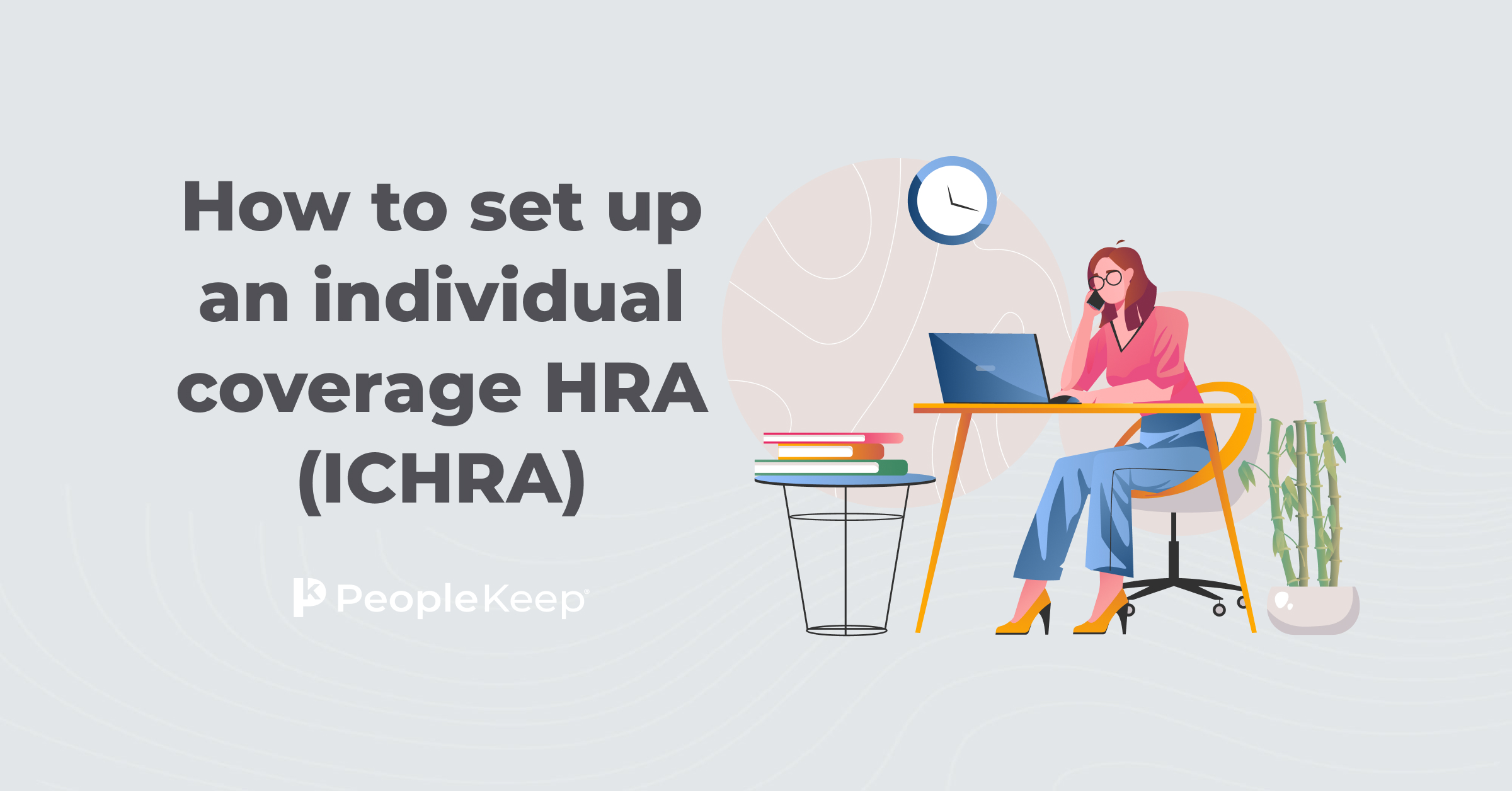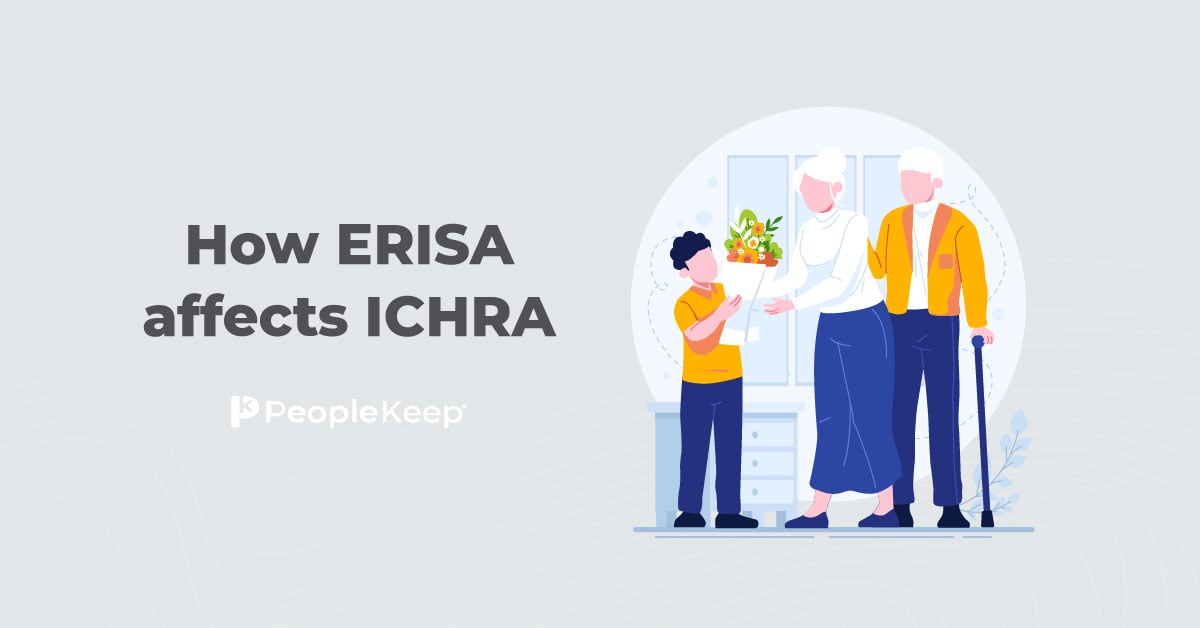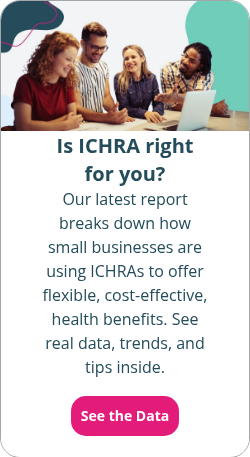What is an ICHRA?
By Chase Charaba on August 15, 2024 at 9:42 AM
Imagine being able to offer a health benefit without the cost or complexity of a group plan. This is the idea behind an individual coverage health reimbursement arrangement (ICHRA). An ICHRA allows employers to reimburse employees, tax-free, for qualifying medical expenses.
In this article, we will explore what an ICHRA is, how it works, and how it compares to other health reimbursement arrangements (HRAs). We’ll also outline who can offer and participate in an ICHRA.
You'll learn the following in this blog post:
- How an ICHRA allows employees to choose their own health insurance
- Which organizations are eligible to offer an ICHRA
- What type of health coverage employees must have to participate in the ICHRA
What is an ICHRA? A brief overview
The ICHRA is a relaltively new health benefit that launched in 2020. With it, organizations can reimburse employees for their individual health insurance premiums and other qualifying out-of-pocket medical expenses. Unlike a group plan, an ICHRA lets employees choose a health plan that best fits their needs.
Why offer an ICHRA instead of a traditional group health insurance plan?
- It provides flexibility for employers. Instead of buying a group health plan that comes with steep annual rate hikes, employers have a say over their budget. They can decide how much of an allowance they want to offer employees and never pay more than that amount.
- It provides flexibility for employees. With traditional employer-sponsored plans, employees don’t have much choice. Everyone gets the same health plan and coverage, no matter their individual needs or location. With an ICHRA, employees can pick a plan that fits their needs.
Only employers contribute to an ICHRA. This means employees don’t have to contribute any funds from their paychecks.
How does an ICHRA work?
An ICHRA lets employers offer a more personalized, cost-effective health benefit than a group plan. With an ICHRA, employers give their employees a monthly allowance for medical expenses. Employees use it to buy what they need.
Here’s how it works:
- The employer sets a monthly allowance. Employers decide how much tax-free money they want to offer their employees. Allowances can vary based on family status and age. You can even offer different employees different allowance amounts using employee classes.
- Employees get qualifying coverage. To participate in an ICHRA, employees must have a qualifying form of individual health coverage. For example, the plan must meet minimum essential coverage (MEC) standards. If they don’t have the right coverage, they can enroll in the right plan upon the offer of the benefit. That’s because the offer of an ICHRA creates a special enrollment period.
- Employees make healthcare purchases. With their own money, employees pay for the medical care they need. Eligible purchases include insurance premiums, doctor’s office visits, and products like prescriptions. IRS Publication 502 and the CARES Act have complete lists of the items you can reimburse.
- Employees submit proof of their eligible medical care expenses. After incurring a medical expense, employees submit proof of the expense to their employer. Accepted forms of proof include a receipt or an explanation of benefits from an insurance company.
- The employer or HRA administrator reviews and reimburses employee expenses. Each reimbursement request must include the following: the service or product, the date of the service or sale, and the amount incurred. If the medical expense meets eligibility criteria, the employer can approve it. They then reimburse the employee up to their allowance amount. Reimbursements are free of income and payroll taxes.
Who can offer an ICHRA?
Organizations of all sizes can offer an ICHRA. You only need at least one W-2 employee to start offering this benefit.
Organizations that can offer an ICHRA include:
- Nonprofit organizations
- Private companies
- Churches and religious organizations
- Government and municipal entities
While any organization can offer an ICHRA to its U.S. workforce, there are some considerations. You can’t offer an ICHRA if you offer a qualified small employer HRA (QSEHRA) or excepted benefit HRA (EBHRA). You can offer a traditional group health plan alongside an ICHRA, but you can’t offer both benefits to the same class of employees.
For example, you could offer your full-time employees a group plan and part-time employees an ICHRA. But you can’t give either class a choice between a group plan or the ICHRA.
While an ICHRA works well for small employers, it’s also an excellent option for applicable large employers (ALEs)—those with 50 or more full-time equivalent employees (FTEs). With the health benefit, ALEs can meet the Affordable Care Act’s employer mandate—provided their allowance is affordable. ALEs must provide affordable coverage with MEC and minimum value to at least 95% of full-time employees and their dependents.
Who can participate in an ICHRA?
To participate in the ICHRA, employees must have an individual health insurance policy that provides minimum essential coverage (MEC). Plans employees purchased on-exchange or off-exchange coverage, Medicare Parts A and B, or Medicare Part C can meet this requirement. Employees must also be W-2 employees, not independent contractors.
Employees' spouses and legal dependents can also participate, provided they have the right type of coverage. The employer must also choose to extend eligibility to spouses and dependents.
Employers can determine who’s eligible for the benefit with the use of 11 employee classes, like salaried or state-based groups. If you use employee classes, you have to give everyone in that class the same ICHRA benefits.
Business owners can also participate in an ICHRA if the IRS considers them a W-2 employee. Our infographic explains business owner eligibility.
How does an ICHRA work with premium tax credits?
The ICHRA doesn’t work with premium tax credits. If an employee participates in the ICHRA, they can’t collect their tax credits. Employees can collect premium tax credits and decline the ICHRA depending on affordability. If an employee’s ICHRA allowance is affordable, they can’t claim any premium tax credits. If their allowance is unaffordable, they can decline the ICHRA and claim their tax credits.
Learn more with our guide to premium tax credits with an ICHRA.
Are there other types of HRAs available?
An ICHRA isn’t the only type of HRA available. PeopleKeep can help you offer one of three types of HRAs, including the ICHRA.
The qualified small employer HRA (QSEHRA) works like an ICHRA. It allows you to reimburse employees for individual health insurance and out-of-pocket expenses. However, only employers with fewer than 50 FTEs can offer a QSEHRA.
There’s also the group coverage HRA (GCHRA). This type of HRA supplements a group health plan. With it, employers can reimburse employees for out-of-pocket expenses the group plan doesn’t cover. Examples of eligible expenses include deductibles and copays. A GCHRA doesn’t reimburse employees for insurance premiums.
Where can I learn more about the ICHRA?
If you’re interested in learning more about the ICHRA, our resources can help:
- Guide to the individual coverage HRA (ICHRA): This complete guide to the ICHRA covers the benefit in more depth.
- 2023 ICHRA report: See how PeopleKeep customers used their ICHRA benefits from July 2022 to June 2023.
Conclusion
When it comes to health coverage for your team, it’s a good idea to look beyond traditional group health plans. An ICHRA has more design flexibility than group policies. It gives employers a cost-effective way to offer personalized health benefits to their employees. It also empowers employees with the freedom of choice when it comes to healthcare services and coverage options.
If you want to offer an ICHRA to your employees, PeopleKeep can help! Our ICHRA administration software makes it easy to set up and manage your benefit in minutes each month. Schedule a demo with an HRA specialist or learn more about our software.
This blog post was originally published on January 8, 2019. It was last updated on August 13, 2024.
Check out more resources
See these related articles

How to set up an individual coverage HRA (ICHRA)
Ready to offer ICHRA? Follow this guide to learn how to set up an Individual Coverage HRA, from plan design to compliance and employee communication.

How ERISA affects ICHRA
Understand how ERISA compliance affects your ICHRA plan with this informative guide. Learn the key regulations and requirements to ensure compliance.

Who is eligible for the individual coverage HRA (ICHRA)?
Find out who qualifies for the Individual Coverage HRA (ICHRA). Explore ICHRA eligibility rules and how they benefit both employers and employees.



